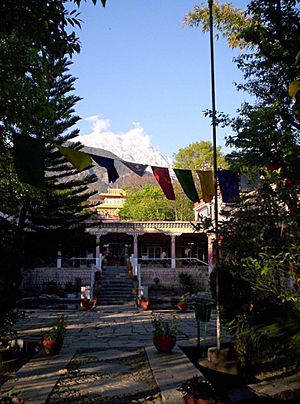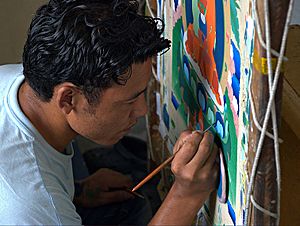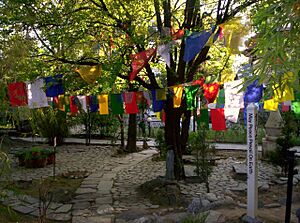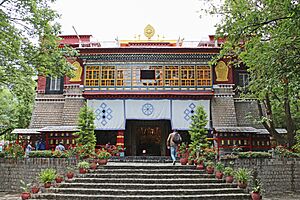Norbulingka Institute facts for kids
- You may have been looking for Norbulingka Palace.

Norbulingka Institute, with Dhauladhar range in the background.
|
|
| Established | 1995 |
|---|---|
| Location | |
The Norbulingka Institute was started in 1995 by Kelsang and Kim Yeshi. It is located in Sidhpur, near Dharamshala, India. This special place works to keep Tibetan culture alive, especially its stories, art, and traditions.
Contents
Why the Name Norbulingka?
The institute gets its name from Norbulingka. This was the traditional summer home for the Dalai Lamas in Lhasa, Tibet. The way the institute is planned out is based on the shape of Avalokitesvara. This is a thousand-armed god of kindness, with the main temple being like the head.
What Norbulingka Institute Does
Norbulingka is all about passing down Tibetan traditions. It helps restore old ways of doing things by offering training, education, and jobs for Tibetans. The institute creates a place where Tibetan community and family values can grow. It also connects old traditions with new ideas in a respectful way. Norbulingka wants people around the world to learn about Tibetan values and their art and literature.
The institute makes beautiful, traditional art objects. They also create clothing and things for homes. Visitors can take free guided tours of the institute every day except Sunday. If you want to learn Tibetan arts, workshops are also available. The institute runs two guesthouses called Norling Guesthouse and Chonor House. All the money earned from Norbulingka's projects goes back into the institute. This helps them continue their work to protect Tibetan culture.
Art and Craft Studios
Norbulingka has many art studios. Here, artists learn and practice different skills. These include making Tibetan statues and painting thangkas. They also do screen-printing, applique, and tailoring. Other crafts are woodcarving, wood painting, and making paper. There are also studios for wood and metal crafts.
Learning at the Academy
The Academy of Tibetan Culture opened in 1997. It offers a three-year course for higher education. Students learn about traditional Tibetan studies. They also study English, Chinese, and world history.
Research and History
The Research Department at Norbulingka has a team working on the official story of the Dalai Lama's life. Nine books in Tibetan have already been published. This research section is also putting together a big encyclopedia about Tibetan culture.
The Seat of Happiness Temple
The institute also has a two-story building called the 'Seat of Happiness Temple' (Deden Tsuglakhang). It was built in 1985 and is surrounded by beautiful gardens. The temple is famous for its 1,173 paintings of Buddha. It also has paintings of all the Dalai Lamas. There are drawings that show the life story of the 14th Dalai Lama.
In the main hall, there is a 4-meter-tall golden copper statue of Buddha Sakyamuni. This statue was made by the institute's master statue-maker, Chenmo Pemba Dorje. It is one of the largest statues of its kind outside of Tibet. Around the temple, you can find workshops where artists and students create various art objects. These items are sold at the Norbulingka Shop. The money helps Tibetan refugees.
Losel Doll Museum
The Losel Doll Museum has special displays called dioramas. These shows traditional Tibetan scenes. They use small Tibetan dolls dressed in traditional clothes.
Nearby Places
Close to the institute, you can find the Dolma Ling Buddhist nunnery. There is also the Gyato Monastery, which is the temporary home of the 17th Karmapa, Ogyen Trinley Dorje.
See also
- Tibetan Institute of Performing Arts




